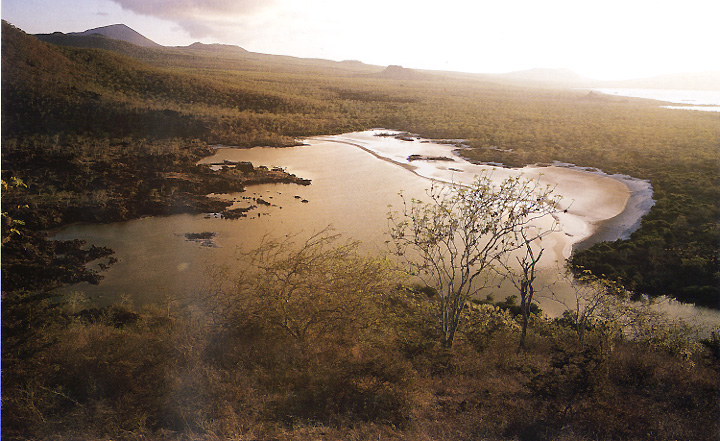|
Description of the Galapagos Islands Isla Floreana  | | Isla Floreana Sunset. Picture source: http://www.geo.cornell.edu/geology/GalapagosWWW/Floreana.html |
Floreana, also known as Charles or Santa Maria Island, is the southeasternmost island in the archipelago. It is one of the smaller of the major islands, measuing approximately 12 by 15 km and rising to an elevation of 640 m (2000 feet). The oldest lavas on Floreana are 1.5 million years old, making it one of the older islands. At the other extreme, Captain Porter of the U.S.S. Essex reported witnessing an eruption in the center of the island in July, 1813. Though the products of this eruption have not been identified, there are a number of young flows and the island is covered with many young pyroclastic cones (pyroclastic cones are produced when lava it thrown into the air explosively), particularly in the highlands. All of these observations testify that Floreana remains an active volcano.
Floreana represents one extreme of the range of lava compositions encountered on the islands. Basalts here are distinctly more "alkalic" in composition, as opposed to the more "tholeiitic" compositions produced by most volcanoes. "Alkalic" magmas are often richer in water and CO2, gases that drive explosive eruptions. Thus the compositional difference probably accounts for the abundance of pyroclastic cones. Trace element abundances in these lavas indicate that Floreana magmas are produced at shallower depth in the mantle and by smaller extents of melting than in the rest of the archipelago. This may well reflect its position on the southern periphery of the archipelago, where the the Galapagos Mantle Plume is cooled by contact with surrounding mantle.
Floreana is one of the few islands with a reliable supply of fresh water, an artisian spring at the base of Cerro Olympus in the lush southeast highlands. Because of this, it has a long history of colonization, the first settler being an Irish seaman stranded on the island in the early nineteenth century. Among the more recent colonists was the Wittmer family, who settled there in 1932. Frau Wittmer, now in her ninties, still lives there with some of her childern, grandchildren, and great-grandchildern. A bizarre series of unexplained deaths occurred around that time, and are described in Frau Wittmer's excellent book Postlagernd Floreana (the English translation is titled simply Floreana). The book takes its name from the Post Office Barrel established on Post Office Bay in 1894 by Captain James Colnett, who was on a exploration voyage for the British Admiralty. Whalers could leave mail in the barrel to be picked up by other ships returning to port. This "Post-Office" may still be seen today. The long history of settlement has adversely affected the native flora and fauna. The Floreana race of giant tortoises was extinct by 1846. However, flamingos may still be seen in Flamingo Bay (above) and sea turtles may be seen nesting on the beach near Cormorant Point.
|







